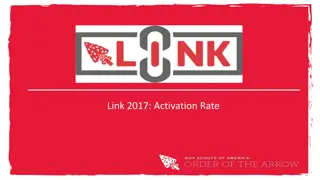Exploring the Latest Research on Carotid Artery Disease Treatment
This comprehensive update discusses recent findings and ongoing studies related to carotid artery disease treatment options, particularly focusing on revascularization procedures in symptomatic and asymptomatic patients. Key trials like ECST-2, ACTRIS, EVA-3S, SPACE, ICSS, CREST, and more are highlighted, shedding light on the comparative effectiveness of carotid endarterectomy (CEA) versus carotid artery stenting (CAS). The information presented aims to guide clinicians in making evidence-based decisions for managing patients with varying risks and clinical presentations in this challenging clinical scenario.
- Carotid artery disease
- Revascularization
- Carotid endarterectomy
- Carotid artery stenting
- Clinical trials
Download Presentation

Please find below an Image/Link to download the presentation.
The content on the website is provided AS IS for your information and personal use only. It may not be sold, licensed, or shared on other websites without obtaining consent from the author. Download presentation by click this link. If you encounter any issues during the download, it is possible that the publisher has removed the file from their server.
E N D
Presentation Transcript
Hirnschlagzentrum/Stroke Center ECST-2 and ACTRIS Update Prof Leo Bonati Department of Neurology and Stroke Center Department of Clinical Resarch University Hospital Basel ACST-2 Collaborators Meeting, Oxford, 4-5.9.2017
RCTs in Carotid Artery Disease Symptomatic Revascularisation needed, uncertain if CAS or CEA CAS vs. CEA EVA-3S, SPACE, ICSS, CREST
RCTs in Carotid Artery Disease Symptomatic, 5-year risk <20% Symptomatic Revascularisation needed, uncertain if CAS or CEA Revascularisation uncertain CAS vs. CEA EVA-3S, SPACE, ICSS, CREST Revasc vs. BMT ECST-2
RCTs in Carotid Artery Disease Symptomatic, 5-year risk <20% Symptomatic Asymptomatic Revascularisation needed, uncertain if CAS or CEA Revascularisation needed, uncertain if CAS or CEA Revascularisation uncertain CAS vs. CEA EVA-3S, SPACE, ICSS, CREST Revasc vs. BMT ECST-2 CAS vs. CEA SPACE-2 , CREST, ACT-1, ACST-2
RCTs in Carotid Artery Disease Symptomatic, 5-year risk <20% Symptomatic Asymptomatic Revascularisation needed, uncertain if CAS or CEA Revascularisation needed, uncertain if CAS or CEA Revascularisation uncertain Revascularisation uncertain CAS vs. CEA EVA-3S, SPACE, ICSS, CREST Revasc vs. BMT ECST-2 CAS vs. CEA SPACE-2 , CREST, ACT-1, ACST-2 Revasc vs. BMT SPACE-2, ECST-2 CREST-2, ACTRIS
RCTs in Carotid Artery Disease Symptomatic, 5-year risk <20% Symptomatic Asymptomatic Revascularisation needed, uncertain if CAS or CEA Revascularisation needed, uncertain if CAS or CEA Revascularisation uncertain Revascularisation uncertain CAS vs. CEA EVA-3S, SPACE, ICSS, CREST Revasc vs. BMT ECST-2 CAS vs. CEA SPACE-2 , CREST, ACT-1, ACST-2 Revasc vs. BMT SPACE-2, ECST-2 CREST-2, ACTRIS CAS vs. CEA
RCTs in Carotid Artery Disease Symptomatic, 5-year risk <20% Symptomatic Asymptomatic Revascularisation needed, uncertain if CAS or CEA Revascularisation needed, uncertain if CAS or CEA Revascularisation uncertain Revascularisation uncertain CAS vs. CEA EVA-3S, SPACE, ICSS, CREST Revasc vs. BMT ECST-2 CAS vs. CEA SPACE-2 , CREST, ACT-1, ACST-2 Revasc vs. BMT SPACE-2, ECST-2 CREST-2, ACTRIS Revasc vs. BMT CAS vs. CEA
RCTs in Carotid Artery Disease Symptomatic, 5-year risk <20% Symptomatic Asymptomatic Revascularisation needed, uncertain if CAS or CEA Revascularisation needed, uncertain if CAS or CEA Revascularisation uncertain Revascularisation uncertain CAS vs. CEA EVA-3S, SPACE, ICSS, CREST Revasc vs. BMT ECST-2 CAS vs. CEA SPACE-2 , CREST, ACT-1, ACST-2 Revasc vs. BMT SPACE-2, ECST-2 CREST-2, ACTRIS Revasc vs. BMT CAS vs. CEA Carotid Stenosis Trialists Collaboration
The Second European Carotid Surgery Trial (ECST-2) Coordinating centre: UCL Institute of Neurology, London PI: Martin Brown
Symptomatic carotid stenosis: NASCET, ECST und VA n=6092 patients Perioperative death or stroke, or ipsilateral ischaemic stroke during follow-up Moderate stenosis (50-69%) Severe stenosis ( 70%) Medical Medical ARR 5% ARR 16% Ye ars Endarterectomy Endarterectomy years Rothwell et al., Lancet 2003; 361: 107 16
Strokes prevented by CEA in patients with symptomatic 50-99% stenosis after 5 years @ Eline Kooi
Do all patients with symptomatic stenosis benefit equally from surgery? ARR ARR Sex Men Women Age (years) <65 65-74 74 Weeks since event <2 2-4 4-12 12 Benefit is highest in men, older patients, and if treated within 2 weeks of symptoms Rothwell et al., Lancet 2004; 363: 915 24
ECST risk model predicts 5-year stroke risk under medical therapy in NASCET trial population 50 Patients on medical treatment in NASCET 40 Observed risk (%) 30 Risk of CEA in NASCET 20 10 0 0 10 20 30 40 50 <20% Predicted medical risk (%) Rothwell PM. Lancet 2005; 365: 256 265
ECST-2 hypotheses In patients with 50% symptomatic or asymptomatic carotid stenosis and a predicted 5-year stroke risk <20%, optimised medical therapy (OMT) alone is as effective in the long-term prevention of stroke as carotid revascularisation (CEA or CAS) plus OMT Plaque imaging helps select patients who benefit from revascularisation Primary outcome: any stroke or myocardial infarction, or procedural death Secondary outcomes: 2-year risk of cerebral infarcts on MRI, cognitive impairment (MoCa), disability
Predicting risk of recurrent stroke in patients with symptomatic stenosis ECST risk model 70-99% stenosis Ulcer - 50-69% stenosis Ulcer - Men Ulcer + Ulcer + ECST-2 CAR Score App available on AppStore and PlayStore Low 5-year risk ipsilateral stroke risk (<10%) Intermediate 5-year ipsilateral stroke risk (10-19%) High 5-year risk ipsilateral stroke risk (>20%) ECST-2 Rothwell PM. Lancet 2005; 365: 256 265
Symptomatic or asymptomatic carotid stenosis ECST-2 trial profile >20% risk: Revascularisation recommended CAR Score (5-year stroke risk) 20% risk: Eligible for ECST-2 Randomisation in ECST-2 OMT + Revasc Group OMT Group Baseline MRI brain + plaque, US plaque Blood sample Revascularisation 2-year MRI brain Blood sample Clinical follow-up minimum 5 years, maximum 10 years
ECST-2: Optimised medical treatment (OMT) Antiplatelet therapy: clopidogrel or aspirin and dipyridamole. Anticoagulation allowed if necessary. Statins adjusted to maintain a target total cholesterol <4.0mmol/L, and an LDL cholesterol level <2.0mmol/L, together with low cholesterol diet. Antihypertensive treatment, adjusted to maintain a target BP of 140/90 mmHg or less. Targeted risk factor modification: smoking, body weight, glycaemic control (HbA1c<6.5%), exercise.
Status of ECST-2 Pilot funding from NIHR and Stroke Association Plaque and brain imaging and biomarker analysis during pilot phase funded by Swiss National Science Foundation 30 active centres 262 patients randomised (target pilot n=320, full trial n=2000 patients) New centres welcome Contact: office@ecst2.com
ACTRIS ENDARTERECTOMY COMBINED WITH OPTIMAL MEDICAL THERAPY VERSUS OPTIMAL MEDICAL THERAPY ALONE IN PATIENTS WITH ASYMPTOMATIC SEVERE ATHEROSCLEROTIC CAROTID ARTERY STENOSIS AT HIGH RISK OF IPSILATERAL STROKE PI: Jean-Louis Mas
ACTRIS Objectives Primary objective To assess whether carotid endarterectomy combined with optimal medical therapy improves long-term survival free of ipsilateral stroke (or periprocedural stroke or death) when compared with optimal medical therapy alone. Secondary objectives To assess differences between groups with regard to risks of any stroke (or periprocedural death), any disabling or fatal stroke (or periprocedural death), any stroke or death, myocardial infarction, cardiovascular death, symptomatic and asymptomatic lesions on brain MRI at 2 years, disability, cognitive impairment, health-related quality of life and depression. To assess to what extent medical treatment objectives can be achieved and identify factors associated with goals achievement.
ACTRIS Main inclusion criteria Age 50 years or over No ipsilateral stroke or TIA within 180 days of randomisation Atherosclerotic carotid stenosis between 60 and 99% (NASCET method) At least one of the following: TCD-detected microembolic signals Impairment of TCD-measured cerebral vasomotor reserve Intraplaque haemorrhage on magnetic resonance imaging Rapid stenosis progression High probability to live at least 5 years
ACTRIS Optimal medical treatment OMT will follow guidelines for clinical practice and consist of: antiplatelet therapy high-dose statin treatment (target LDL < 0.7 g/l - <1.8mmol/L) antihypertensive treatment (target BP < 140/90 mmHg) lifestyle modification (quitting smoking, healthy food, reduction of alcohol consumption, regular physical activity, overweight reduction) Application of structured programs, such as rigorous stepped-care approach using ranking of antihypertensive and lipid-lowering drugs will be used.
ACTRIS Number of subjects Primary endpoint Ipsilateral stroke (or periprocedural stroke or death) Number of subjects = 700 5-year rate of the primary endpoint of 12.5% in the OMT arm. Two-sided significance level of =5%, power of 80% 60% reduction of the primary endpoint in the endarterectomy arm Accrual period: 3 years, maximal follow-up time: 6 years, 10% anticipated dropouts rate: 10%.























